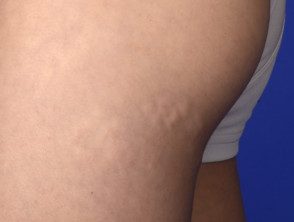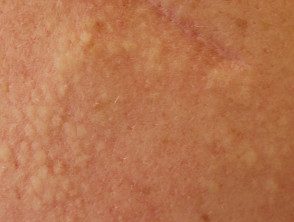What is Buschke-Ollendorff? syndrome?
Buschke-Ollendorff syndrome refers to a rare, hereditary disorder affected connective tissues. Also known as disseminated lenticularis dermatofibrosis, dermatoosteopoikilosis and family cutaneous collagenome
Who gets Buschke-Ollendorff syndrome?
Buschke-Ollendorff syndrome occurs in 1 in 20,000 live births worldwide. There seems to be no race, sexual or geographic predilection. Lesions are present at birth.
What causes Buschke-Ollendorff syndrome?
Buschke-Ollendorff syndrome is a genetic disease. The underlying cause of Buschke-Ollendorff syndrome is mutation of the LEMD3 gene, which provides instructions for the manufacture of proteins that support connective tissues.
- The inheritance is in a autosomal recessive pattern (a defective gene must be inherited from both parents).
- May result from abnormal regulation of the the extracellular matrix, resulting in an accumulation of elastin at dermal fur cape
What are the clinical features of Buschke-Ollendorff syndrome?
Buschke-Ollendorff syndrome is characterized by a small connective tissue naevi.
- The torso and extremities are more frequently affected.
- The nevi are elastomas (made of elastin fibers), collagenomas (Made of collagen fibers) or fibroids (made of fibrous tissue).
- They are slightly raised, yellowish papules, nodules or plates.
- These lesions are painless and do not itch.
The non-cutaneous but significant features of Buschke-Ollendorff syndrome include:
- Osteopoikilosis (areas of increased bone density in the long bones of the extremities)
- Nasolacrimal duct obstruction (tear)
- Amblyopia (lazy eye) or strabismus (strabismus)
- Benign lymphoid hyperplasia (growth of lymphatic tissue)
- Short stature
- Mellitus diabetes
- Aortic stenosis (restricted heart valve)
- Hearing impairment / deafness.
Connective tissue nevi

Connective tissue nevi in Buschke Ollendorf syndrome

Connective tissue nevi

Connective tissue nevi
How is Buschke-Ollendorff syndrome treated?
Treatment for Buschke-Ollendorff syndrome may include:
- Surgical excision of connective tissue nevi for aesthetic reasons
- Surgical treatment of deafness, if indicated.
- Surgical treatment or other treatment of associated disorders, such as diabetes mellitus or aortic stenosis.
What is the result of Buschke-Ollendorff syndrome?
The outcome of Buschke-Ollendorff syndrome depends on the associated disorders.
- A leading cause of death related to Buschke-Ollendorff syndrome is the development of areas of bone density in bone cancers such as osteosarcoma, chondrosarcoma, or giant cell tumors
- When there are other disorders such as aortic stenosis or diabetes mellitus, the forecast can be serious
